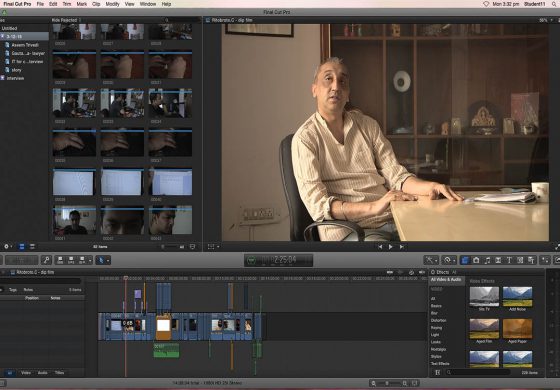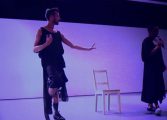Soudhamini V |
I started teaching at Srishti three years ago. Throughout my first year I taught fiction film making, as I knew it both from my own learning in film school and my professional work and life since. It was extremely fulfilling, especially as that batch of students went on to win a clutch of awards both in fiction and non-fiction with their final diploma films. But a design school with its inherently inter-disciplinary cross currents is a high stimulus zone in which everything, including one’s own pedagogy, can be considered afresh. So there was this rather insistent question in my mind whether films emerging from a design school really need to be like those from a film school. The advent of digital technology in cinema had also stirred certain thoughts in my mind regarding an emergent narrative aesthetic, and the classroom became my arena for research along both these trajectories.
Propitiously enough in my second year, the creation of a new department for Contemporary Art Practice, allowed me to take these questions further. I proposed a workshop called Hybrid Narratives, calling for students (all design students, not just film trained) to combine found footage (acknowledging the source) with at least a few shots of their own. The theme I proposed was The Gaze. Both fiction and non-fiction works emerged from this brief, though not everyone actually shot. Some films were spoofs, cutting together different chase sequences from Hollywood, or scrambling the visual to a Bollywood yodeling number. But there were also deeper, more subjective explorations, using the cinema of others as a mask to express quite personal concerns – separation, loss, growing up pains, even emerging sexuality. One student illustrated a poem she wrote, arriving at the most interesting, contrapuntal word-image juxtapositions. Another collected sequences with mirrors from different films to put together a strangely unnerving pastiche of insecurity and narcissism across age and gender. Yet another used animation (on the found footage) to show a woman unraveling under the male gaze. As for non-fiction, there was one deadpan commentary about pornography, cut to the most banal and random series of images, shocking by its sheer absurdity. There was even a very ambitious political history of the Universe made purely from stock footage. A certain notion of critique therefore got built into the work, simply because the making itself was interrogatory of both material and form.
One of the most interesting films that came out of this course was titled In-security. The student began with existing security camera footage that he took from the CCTV in his paying guest accommodation. Then he began performing in front of this camera and roped in a friend as co-performer, thus thumbing his nose at the notion of both security and candid capture. This footage he then cut and pasted onto TV screens and monitors in random Hollywood films, meticulously keying it into the boxes and frames. So we had all kinds of American audiences, lay and celebrity, at home, in television stations, hotels, bars and even presidential suites, watching and exclaiming, doubling over with laughter or getting emotional (apparently) about his antics. The film ends with Nicholas Cage exclaiming in admiration, and our young friend doffing his hat seated in front of his edit suite here in Bangalore. By calling a successive, even compulsive, series of bluffs the young film-maker managed to invoke the whole range of affect of the video image – from surveillance to self gratification.
Returning to the film department, I decided to approach fiction differently. Watching non-linear narratives in cinema, I often get a feeling it was actually scripted linear and then contorted in post production for effect. To explore the non-linear organically, I designed a course titled First Fictions where I asked students to script from their own dreams and memories – both of which are intrinsically non-linear, and also incidentally our first fictions. I do believe this is my favourite Srishti course to date because the most personalized and fragile work arose from here. Here too one student combined home video footage from his childhood with the fictional HD footage that he shot, while for another it was simply the pacing that changed, rendering it pure re-collection, memory flowing into dream and into the present in a seamless circuitry. This was cinema as ‘reverie’, as Gaston Bachelard would put it, bringing unconscious material into the conscious frame, yet without subjecting (or surrendering) it to rational analysis. This was memory as a time category, rather than as content.
In a film school, film-making is the only discipline taught, whereas it is one of many in a design school. This seemingly creates a porous situation where disciplines can inspire and influence each other almost by default. But in reality, it is not so simple. For even within the design disciplines, the same tools and concepts -applied to textile, furniture or business services- create completely different insights and creative solutions. It is not possible therefore to simply ‘translate’ either these skill sets or insights directly into film-making. But becoming aware of different ways of thinking, making and using, provide a context, and a contagion if you will, of thinking one’s own discipline afresh.
The digital too has created both crisis and opportunity for a new film narrative. Trained in celluloid myself, yet having had to work this past decade almost exclusively in video, that too in its variously shifting registers, has often been de-stabilizing, the ground beneath my feet shifting constantly. This generation of students though, are digital born and work with the DSLR still/video cameras, with no mental hangover or hallucinations of other film registers. Engaging with them has on the one hand naturalized the digital for me, and on the other, de-programmed me from certain aesthetic criteria that I had taken as a given in cinema. Let me explain.
Special effects in the digital platform can be highly precise, as the registration system is numeric – i.e. program-able – code. For this same reason, it can also be highly intuitive. With slow motion for instance, 48 frames (twice 24) in celluloid, is a 100 % reduction in speed. With the digital though, the shot can be physically stretched on the timeline to whatever decimal percentage feels right. This surely is the true invocation of memory and dreamtime, neither of which unfold in a given speed for all of us, or is even necessarily in slow motion – that too is perhaps only a celluloid convention. In truth, both memory and dream are nothing but highly differentiated registers of experiential time, regardless of their content! This is the kind of affordance digital technology offers almost by default. It is our conceptual parameters that need to evolve, to take advantage of the technology.
In the fourth semester, I offered ‘Time and Cinema’, as a General Studies or Liberal Arts Course, once again for all students. Gilles Deleuze’s Cinema 1 and 2, and in particular his Time Image has certainly sensitized us to experiencing cinema in a completely new way. But his vision and schema are so over-arching that I was afraid it would inhibit the development of the students’ own perspective. So I began instead with an earlier book of his called Bergsonism, in which he is still formulating his theories on Time, deriving insights from Bergson and re-articulating them for himself. It is a slim book, just five chapters long, but as rigorous and demanding as the later ones, beginning intriguingly enough with a chapter titled ‘Intuition as Method’. There is no mention of cinema at all in the book, but the students read a chapter each week and we saw films together, and I encouraged them to understand one through the other. Simply that. In like spirit, the final essays were not on Deleuze at all, only on the films, but his thought permeated the writing. I find I like using theory like this, to in-form – internally influence – both making and response deeply, itself remaining within the cusp of the conscious-unconscious and never completely surfacing.
This year I have tried to use music in the same fashion. A student pursuing an advanced diploma in film, wrote a script and treatment inspired by classical Hindustani music. It is not a film on music – music is not the subject of the film. It is as balance and measure, in its improvisatory tone and its emotional graph that the film is like music, a theoretical premise derived in part from Sussane Langer’s exquisite work, Feeling and Form. “The tonal structures we call music,” she says, “bear a close logical similarity to the forms of human feeling – forms of growth and of attenuation, flowing and stowing, conflict and resolution, speed, arrest, terrific excitement, calm or subtle activation and dreamy lapses….the greatness and brevity and eternal passing of everything vitally felt. Such is the pattern or logical form of sentience; and the pattern of music is that same form worked out in pure measured sound and silence. Music is a tonal analogue of emotive life”.
Cinema, it seems to me, can be as precise and evocative an audio-visual ‘analogue of emotive life’, something we become poignantly aware of today as we breach the horizon of the analog and begin to approach, even speed, towards the digital.
Soudhamini is a film-maker trained at the prestigious Film and Television Institute of India, Pune. She also has a Masters in English Literature from the Stella Maris College, Madras. She teaches film theory, criticism and practice at both Undergraduate and Post Graduate levels at Srishti.



